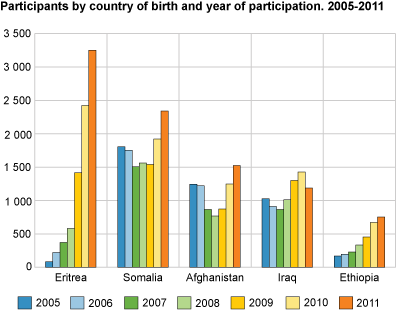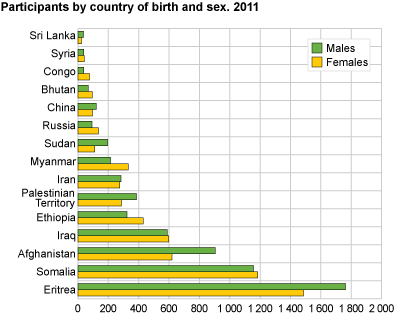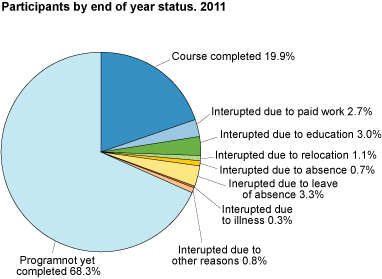Content
Published:
This is an archived release.
More participants in introduction programme
In 2011, 12 800 persons participated in the introduction programme for new immigrants. This is an increase of 18 per cent from the previous year. Nearly 70 per cent of the participants came from Eritrea, Somalia, Afghanistan, Iraq or Ethiopia.
The number of participants in 2011 is thereby the highest since the programme started in 2005.
Most participants from Eritrea
In 2011, the highest number of participants came from Eritrea, followed by Somalia, Afghanistan, Iraq and Ethiopia. Eritrea had the highest increase compared with the previous year, with 34 per cent more participants.
Participation in the introduction programme is a right and it is mandatory for new immigrants aged 18 to 55. There are few participants in the higher age groups, and most participants are between 26 and 35 years old. The female share decreases with age.
| Age | All | Sex | Percentage | ||||||||||||||||||||||||||||||||||||||||||||||||||||||||||||||||||||||||||||
|---|---|---|---|---|---|---|---|---|---|---|---|---|---|---|---|---|---|---|---|---|---|---|---|---|---|---|---|---|---|---|---|---|---|---|---|---|---|---|---|---|---|---|---|---|---|---|---|---|---|---|---|---|---|---|---|---|---|---|---|---|---|---|---|---|---|---|---|---|---|---|---|---|---|---|---|---|---|---|---|
| Males | Females | Males | Females | ||||||||||||||||||||||||||||||||||||||||||||||||||||||||||||||||||||||||||||
| Total | 12 817 | 6 550 | 6 267 | 51 | 49 | ||||||||||||||||||||||||||||||||||||||||||||||||||||||||||||||||||||||||||
| Under 25 | 3 382 | 1 909 | 1 473 | 56 | 44 | ||||||||||||||||||||||||||||||||||||||||||||||||||||||||||||||||||||||||||
| 26 - 35 | 5 602 | 2 742 | 2 860 | 49 | 51 | ||||||||||||||||||||||||||||||||||||||||||||||||||||||||||||||||||||||||||
| 36 - 45 | 2 785 | 1 330 | 1 455 | 48 | 52 | ||||||||||||||||||||||||||||||||||||||||||||||||||||||||||||||||||||||||||
| 46 - 55 | 900 | 473 | 427 | 53 | 47 | ||||||||||||||||||||||||||||||||||||||||||||||||||||||||||||||||||||||||||
| 56 -> | 148 | 96 | 52 | 65 | 35 | ||||||||||||||||||||||||||||||||||||||||||||||||||||||||||||||||||||||||||
High share of participants from Myanmar and Eritrea
The number of participants as a share of the total number of immigrants in a certain year can be a useful measure of participation. Among those who immigrated in 2011, there were, however, many who were unable to start until the end of the year. It is therefore better to look at those who immigrated in 2010 and their participation in the programme in 2011. For immigrants settled in Norway during 2010, the highest degree of participation in 2011 was among those from Myanmar and Eritrea.
Most participants in Oslo
In 2011, as in the previous years, there were most participants in Oslo. Bergen, Trondheim, and Kristiansand followed next.
Many stay in the programme
Sixty-eight per cent of the participants in 2011 were still registered in the programme at the end of the year. Twenty per cent completed the full duration of the programme, while 6 per cent completed early to transfer to work or education.
Norwegian the most important course
The introduction programme consists of several types of schemes or courses, the most important being Norwegian with social studies. Ninety per cent participated in this course during 2011. Thirty-four per cent participated in language practice, which was the second most attended course. Language practice is a component in the language training where the participants spend part of the week in a workplace to get hands-on language practice.
| Sex |
Number of participants
in the introduction programme all year |
Of which, long-term
recipients of social assistance |
Share long-term
recipients of full year participants |
||||||||||||||||||||||||||||||||||||||||||||||||||||||||||||||||||||||||||||
|---|---|---|---|---|---|---|---|---|---|---|---|---|---|---|---|---|---|---|---|---|---|---|---|---|---|---|---|---|---|---|---|---|---|---|---|---|---|---|---|---|---|---|---|---|---|---|---|---|---|---|---|---|---|---|---|---|---|---|---|---|---|---|---|---|---|---|---|---|---|---|---|---|---|---|---|---|---|---|---|
| All | 4 494 | 794 | 18 | ||||||||||||||||||||||||||||||||||||||||||||||||||||||||||||||||||||||||||||
| Males | 2 486 | 437 | 18 | ||||||||||||||||||||||||||||||||||||||||||||||||||||||||||||||||||||||||||||
| Females | 2 008 | 357 | 18 | ||||||||||||||||||||||||||||||||||||||||||||||||||||||||||||||||||||||||||||
Some received social assistance
Every participant in the introduction programme receives a “salary”, or an introduction benefit. One of the important ideas behind this payment is to create an alternative to social assistance.
Among the 4 500 who received introduction benefit for the whole of 2011, nearly 800 persons, or 18 per cent, received social assistance in addition to the introduction benefit for at least six months. In 2010 this share was 16 per cent.
Tables:
- Table 1 Participants, by country of birth and sex. 2011
- Table 2 Participants, by municipality of Introduction programme and sex. Absolute figures and percent. Selected municipalities. 2011
- Table 3 Participants, by end of year status, sex and county. 2011
- Table 4 Participants, by county, sex and type of course. 2011
- Table 5 Participants by country of birth, sex and year of immigration. 2011
- Table 6 Participants by end of year status. 2007-2011
- Table 7 Participants who have had paid work in addition to particpating in the programme, by year end of year status and sex. Absolute figures and percent. 2011.
- Table 9 Persons receiving introduction benefit all 2010, who were also long-term recipients of social assistance in 2011, by county
Contact
-
Kari Kraakenes
E-mail: kari.kraakenes@ssb.no
tel.: (+47) 90 70 36 61
-
Harald Lunde
E-mail: harald.lunde@ssb.no
tel.: (+47) 40 81 13 13




